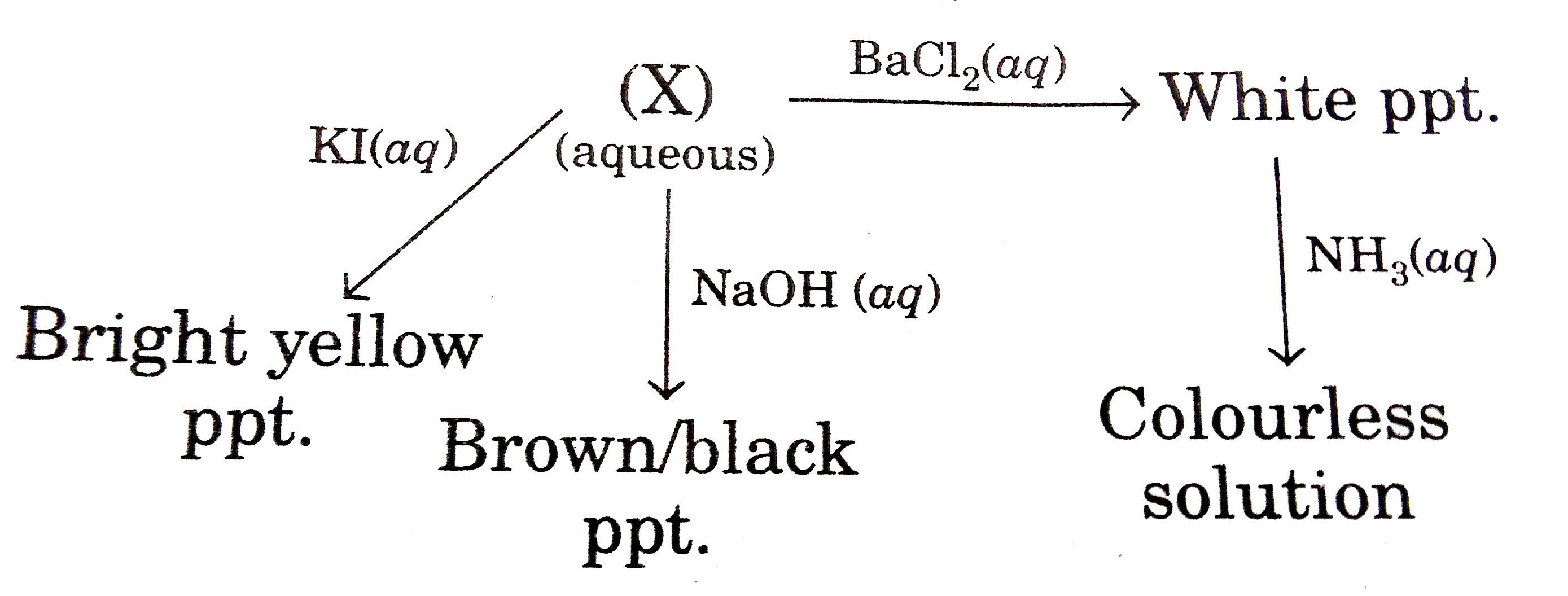Complete Solutions to G: Ist Group Cations of chapter SALT ANALYSIS of Class 11 book with complete answers and questions
| Class 11 | CHEMISTRY |
| Chapter | SALT ANALYSIS |
| GRB PUBLICATION | G: Ist Group Cations |
| Number Of Questions | 20 |
| Academic Year | 2023-24 |
A compound (X) reacts in the following ways:

The compound (X) is likely to be:
View SolutionTo a solution of a substance, gradual addition of ammonium hydroxide results in a brownish black precipitate which does not dissolve in excess of `NH_(4)OH`. However, when KI (no in excess) is added to the original solution, a green precipitate is formed. The solution contained:
View SolutionIdentity the compound which turns black with ammonia solution.
View SolutionA white crystalline substance dissolves in water.On passing `H_(2)S` in this solution, a black precipitate is obtained.The black precipitate dissolves completely in hot `HNO_(3)`.On adding a few drops of concentrated `H_(2)SO_(4)`, a white precipitate is obtained.This precipitate is that of
View SolutionThe composition of golden spangles is
View SolutionIn which of the following solvents, AgBr will have the highest solubility?
View SolutionA metal nitrate solution reacts with dilute hydrochloric acid to give a white precipitate which is soluble in concentarted potassium chloride. White precipitate on passing of hydrogen sulphidegas is converted into black precipitation. The black precipitate on boiling with hydrogen peroxide (3%) is converted again to a white precipitate which is soluble in ammonium acetate. The cation of the metal nitrate is:
View SolutionA metal nitrate solution does not give white precipitate with concentrated hydrochloric acid but on dilution with water produces a white precipitate. The metal nitrate solution with `K_(2)CrO_(4)` and `Na_(2)HPO_(4)` reagents gives red and yellow precipitates respectively which are soluble in ammonia solution. The cation of the metal nitrate is:
View SolutionHow can `0.1g` samples of the two white solids, lead (II) chloride and silver chloride, be distinguished from one another?
View SolutionA sample of sparingly soluble `PbI_(2)(s)` containing radioactive `I-133` is added to `0.10M KI(aq)` and stirred overnight. Observations about this system include which of the following?
(P) The radioactivity of the liquid phase increases significantly.
(Q) The concentration of the `I^(-)` ion in solution increases significantly.
View SolutionWhich solid does not react with a small amount of 3 `M HNO_(3)`?
View SolutionA `2.0mL` sample of a colourless solution, when treated with a few drops of `2M` hydrochloric acid, forms a while precipitate which dissolves when the solution is heated to boiling. The original solution could have contained which of the following cations?
(P) `0.1M Ag^(+)` (Q) `0.1M Pb^(2+)`
View SolutionWhich of the following substance cannot be obtained when `Hg_(2)F_(2)` is reacted with water?
View SolutionA metal nitrate reacts with `Kl` solution to give yellow precipitate which on addition of excess of more concentrated solution `(6 M)` of `Kl` dissolves forming a solution.The cation of metal nitrate is:
View SolutionThree separate samples of a solution of a single salt gave these results. One formed a white precipitate with excess ammonia solution, one formed a white precipitate with dilute `NaCl` solution and one formed a black precipitate with `H_(2)S`.The salt could be:
View Solution`Cu^(2+)` and `Ag^(+)` are both present in the same solution.To precipitate one of the ions and leaves the other in solution, add
View SolutionConsider the following observation:
`M_(n+) + HCl` (dilute) `to` white precipitate `overset(Delta)to` water soluble `overset(CrO_(4)^(2-)`yellow precipitate.
The metal ion `M^(n+)` will be:
View SolutionA white crystalline substance dissolves in water.On passing `H_(2)S` in this solution, a black precipitate is obtained.The black precipitate dissolves completely in hot `HNO_(3)`.On adding a few drops of concentrated `H_(2)SO_(4)`, a white precipitate is obtained.This precipitate is that of
View SolutionA red solid is insoluble in water. However, it becomes soluble if some KI is added to water. Heating the red solid in a test tube results in liberation of some violet coloured fumes and droplets of a metal appear on the cooler parts of the test tube. The rod solid is:
View SolutionMercurous ion is represent as
View Solution
G: Ist Group Cations questions and complete solutions for chapter SALT ANALYSIS of GRB CHEMISTRY (HINGLISH) of Class 11
All Exercises from GRB PUBLICATION Class 11 CHEMISTRY SALT ANALYSIS
- A. Experimental (Laboratory/Apparatus Based)
- B. Dry Tests/Colour/Solubility/Heating Effects
- C.Class- A Subgroup-I-Acidic Radicals
- Comprehension
- Comprehension 1
- Comprehension 10
- Comprehension 11
- Comprehension 12
- Comprehension 13
- Comprehension 14
- Comprehension 15
- Comprehension 16
- Comprehension 17
- Comprehension 18
- Comprehension 19
- Comprehension 2
- Comprehension 20
- Comprehension 21
- Comprehension 22
- Comprehension 23
- Comprehension 24
- Comprehension 25
- Comprehension 26
- Comprehension 27
- Comprehension 28
- Comprehension 29
- Comprehension 3
- Comprehension 30
- Comprehension 31
- Comprehension 32
- Comprehension 33
- Comprehension 34
- Comprehension 35
- Comprehension 36
- Comprehension 37
- Comprehension 38
- Comprehension 39
- Comprehension 4
- Comprehension 40
- Comprehension 41
- Comprehension 42
- Comprehension 43
- Comprehension 44
- Comprehension 45
- Comprehension 46
- Comprehension 47
- Comprehension 48
- Comprehension 49
- Comprehension 5
- Comprehension 50
- Comprehension 51
- Comprehension 52
- Comprehension 53
- Comprehension 54
- Comprehension 55
- Comprehension 56
- Comprehension 57
- Comprehension 58
- Comprehension 59
- Comprehension 6
- Comprehension 7
- Comprehension 8
- Comprehension 9
- D.Class-A Subgroup-II Acidic Radicals
- E.Precipitation/Redox Reacttions
- F.Zero Group Cations
- G: Ist Group Cations
- H: IInd Group Cations
- I. IIIrd Group Cations
- J: IVth Group Cations
- K: Vth and Vth Group Cations
- L: Miscellaneous
- Match The Column Type
- Multiple Objective Type
- Reasoning Type
- Subjective Type